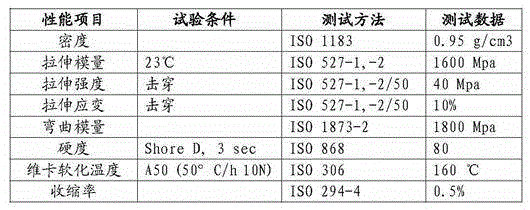Polypropylene for 3D printing, polyethylene composite consumable and preparation method thereof
A 3D printing, polypropylene technology, applied in the field of polypropylene and polyethylene composite consumables and their preparation, can solve the problem of inability to take into account environmental protection and industrial applications at the same time, 3D products do not have high impact resistance, not suitable for high temperature requirements, etc. problems, to achieve good anti-corrosion effect, increase molding stability, surface stiffness and good anti-scratch properties
- Summary
- Abstract
- Description
- Claims
- Application Information
AI Technical Summary
Problems solved by technology
Method used
Image
Examples
Embodiment 1
[0044] Using 60% polypropylene, 27% polyethylene, 10% inorganic filler, 2% nucleating agent and 1% tackifier, wherein the inorganic filler in this embodiment is an ultra-pure ultra-thin powder with a diameter of 2000 mesh. Fine nanoscale calcium carbonate is prepared into 3D printing consumables through the following steps:
[0045] ①. Mix 60% polypropylene, 27% polyethylene, 10% calcium carbonate, 2% nucleating agent and 1% tackifier in proportion;
[0046] ② Put the prepared raw materials into the dryer and dry them at a temperature of 90°C-100°C for more than 2 hours to reduce the moisture content of the raw materials to 0.2%-0.5%;
[0047] ③. Put the dried raw materials into a plastic mixer and mix them thoroughly for 30 minutes;
[0048] ④. Add the mixed raw materials together into the twin-screw granulator, heat at a temperature of 190°C-220°C, plasticize and dissolve the raw materials in the screw barrel at high temperature, and then extrude the raw materials at a scre...
Embodiment 2
[0058] Adopt 50% polypropylene, 37% polyethylene, 10% inorganic filler, 2% nucleating agent and 1% tackifier, wherein the inorganic filler of this embodiment selects diameter as 2000 order mica powder, Prepare 3D printing consumables through the following steps:
[0059] ①. Mix 50% polypropylene, 37% polyethylene, 10% calcium carbonate, 2% nucleating agent and 1% tackifier in proportion;
[0060] ② Put the prepared raw materials into the dryer and dry them at a temperature of 90°C-100°C for more than 2 hours to reduce the moisture content of the raw materials to 0.2%-0.5%;
[0061] ③. Put the dried raw materials into a plastic mixer and mix them thoroughly for 30 minutes;
[0062] ④. Add the mixed raw materials together into the twin-screw granulator, heat at a temperature of 190°C-220°C, plasticize and dissolve the raw materials in the screw barrel at high temperature, and then extrude the raw materials at a screw speed of 30-60RPM;
[0063]⑤. After the raw material extrude...
PUM
| Property | Measurement | Unit |
|---|---|---|
| Particle size | aaaaa | aaaaa |
Abstract
Description
Claims
Application Information
 Login to View More
Login to View More - R&D
- Intellectual Property
- Life Sciences
- Materials
- Tech Scout
- Unparalleled Data Quality
- Higher Quality Content
- 60% Fewer Hallucinations
Browse by: Latest US Patents, China's latest patents, Technical Efficacy Thesaurus, Application Domain, Technology Topic, Popular Technical Reports.
© 2025 PatSnap. All rights reserved.Legal|Privacy policy|Modern Slavery Act Transparency Statement|Sitemap|About US| Contact US: help@patsnap.com

